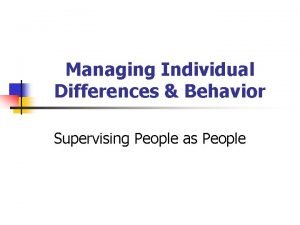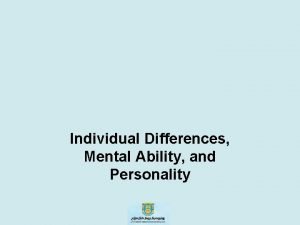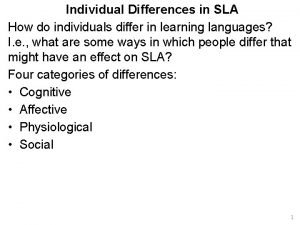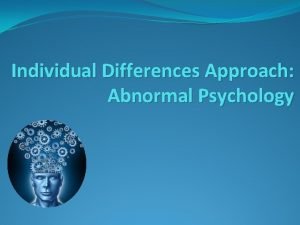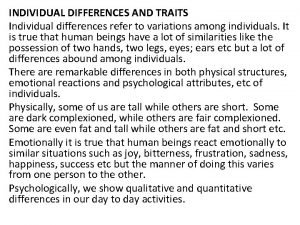Reenvisioning Diversity Individual differences e g personality learning









- Slides: 9

Re-envisioning Diversity Individual differences (e. g. , personality, learning styles, and life experiences) and group/social differences (e. g. , race/ethnicity, sexual orientation, gender, class, country of origin, and ability as well as cultural, political, religious, or other affiliations) that can be engaged in the service of learning. (AAC&U, 2007)

Re-envisioning Inclusion The active, intentional and ongoing engagement with diversity – in people, in the curriculum, in the co-curriculum, and in communities (intellectual, social, cultural, geographical) with which individuals might connect – in ways that increase one’s awareness, content knowledge, cognitive sophistication, and empathic understanding of the complex ways individuals interact within [and change] systems and institutions. (AAC&U, 2007)

Equity-Mindedness A demonstrated awareness of and willingness to: address equity issues among institutional leaders and staff; take stock of the contradictions between the ideals of democratic education and the social, institutional and individual practices, as well as policies, expectations and unspoken rules, that contribute to persistent inequalities in outcomes among different groups; and acknowledge the sociohistorical context of exclusionary practices, racism and the effect of power asymmetries on opportunities and outcomes for those who are underserved, underrepresented or marginalized. (Witham, et al. , 2015)

Principles for Creating Equity by Design 1. 2. 3. 4. 5. Clarity in language, goals and measures Equity-mindedness as the guiding paradigm for language and action Practices and policies designed to accommodate differences in the contexts of students’ learning Continual process of learning, disaggregating data and questioning assumptions about relevance and effectiveness Pervasive institution-wide enactment Education – Adapted from America’s Unmet Promise: The Imperative for Equity in Higher (AAC&U, 2015)

Principle #1: Clarity in Language, Goals and Measures Unclear Example § § § Increase the diversity of our student body. Clear Example § Support the success of all students, particularly those from disadvantaged backgrounds Adopt more global and diverse perspectives in academic curricula and extracurricular offerings. § § All academic departments and student support programs will report to the provost each semester on the participation and/or success rates of students, disaggregated by race/ethnicity. Internal grants or funding requests will prioritize the elimination of disparities in the success rates of students of color. Professional development focused on culturally inclusive pedagogy and practice will be available to all faculty and staff.

Principle #2: Equity-Mindedness as Guiding Paradigm Deficit-Minded Example § Our initiative is designed to help at-risk students make good choices about courses in order to make timely progress toward earning a degree. Clear Example § Our initiative is designed to make academic requirements and sequences more clear and accessible, and to remove barriers that delay students’ progress, particularly for underserved or underrepresented students, toward earning a degree.

Principle #3: Practices and Policies Accommodate Differences Inequitable Design § As a retention strategy, development of a first-year experience program in which student success courses and academic advising are embedded in student housing. However, a large portion of students – including a disproportionate percentage of those not likely to be retained – are commuter students. Equity-Minded Design § As a retention strategy and part of the institution’s general education curriculum, development of a first-year experience program organized around cohorts of students, including residential, commuter and transfer students. Academic and social supports built into students’ schedules depending on the times when they are most likely to be on campus.

Principle #4: Learning, Disaggregating Data and Questioning Assumptions Reform Without Opportunities for Learning § Summer bridge program intended to improve retention rates of students historically “at-risk” of dropping out during the first year, built on a model from an elite institution that also provides students with cultural experiences and tutoring in writing and math. The program is deemed a failure when retention rates have not improved after the first year. Ongoing Learning and Root Cause Analysis § After realizing that a cohort of students is retained at lower rates, and institution surveys first-year students, faculty and staff to determine awareness and utilization of available academic and social supports. The institution then redesigns its summer orientation program so that students and their families have an opportunity to meet with reps from various support services, while also implementing ongoing professional development for faculty and staff on cultural inclusivity.

Principle #5: Pervasive, Institution. Wide Enactment Isolated Effort § As a result of concerns that emerged during an accreditation self-study, the provost appoints a committee to make recommendations to improve retention rates for African-American students. The result is an idea that multicultural student affairs develop a pilot program to provide mentoring to students of color, but budget cuts prevent implementation. Embedded Institution-Wide § As a result of concerns that emerged during an accreditation self-study, the institution's leaders engage in a new strategic planning process focused on improving outcomes for students of color while also improving student success rates overall. Top administrators develop a new plan that will determine how resources could be reallocated to advance excellence and equity. All departments are required to demonstrate how they have aligned their budgets with the goals of the plan.
 Field dependent vs field independent
Field dependent vs field independent Genetic diversity and biodiversity
Genetic diversity and biodiversity Ecosystem jigsaw activity
Ecosystem jigsaw activity Managing individual differences and behavior
Managing individual differences and behavior Managing individual differences and behavior
Managing individual differences and behavior Catering for individual differences
Catering for individual differences Hukum perbedaan individu
Hukum perbedaan individu Gambar perbedaan individu
Gambar perbedaan individu Individual differences factors
Individual differences factors Individual differences in sla
Individual differences in sla



